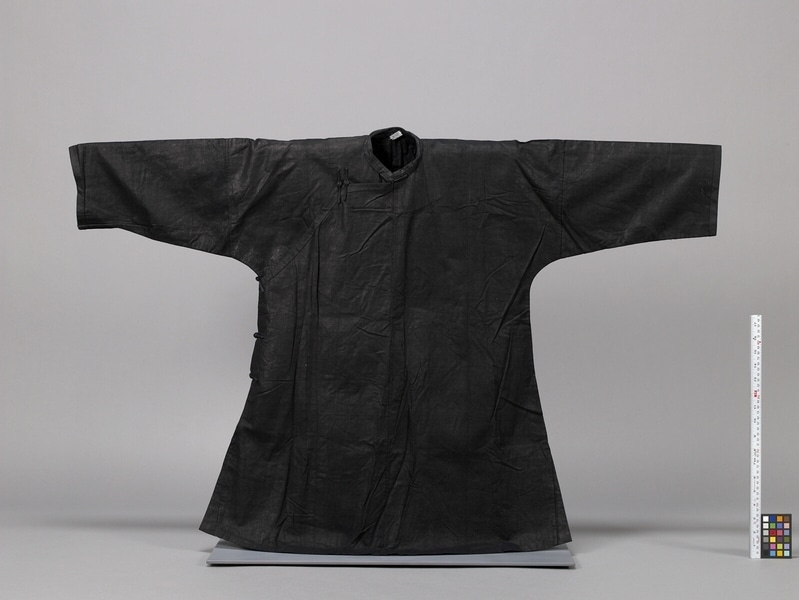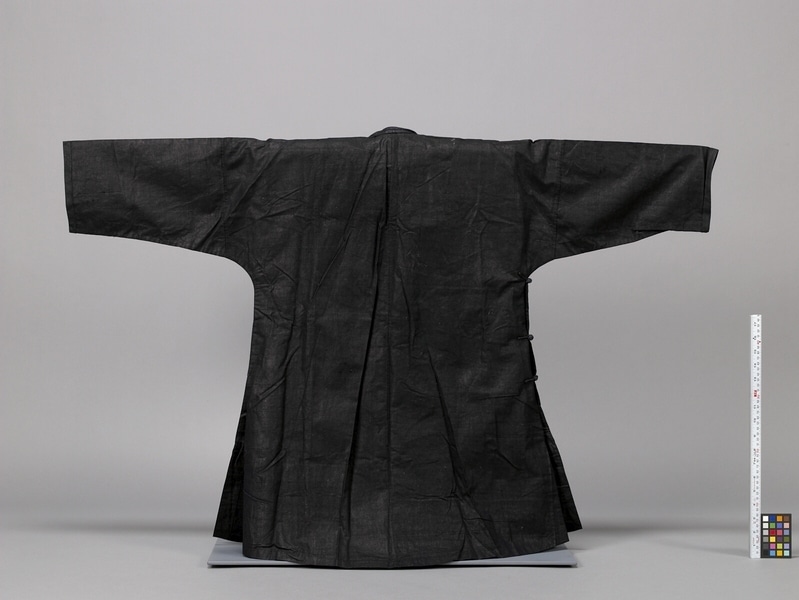Tunic Item Number: Edz1061 from the MOA: University of British Columbia


Description
Wide, flared tunic with a rounded lower edge, made of cotton fabric dyed with heavy purple dye. Round neck with low upright collar. Fastens at side with frog closings. Black trim on neck band, at upper edge of closing, and the ends of the sleeves. Pocket inside the front closing where it overlaps.
History Of Use
Such sets of tunics and pants, if made of cotton or hemp, were worn by women while doing farm work or cutting grass for fuel. Hakka women were known for their ability to do heavy labouring work outdoors. Their clothing in general was plain, decorated only with the hand-woven bands worn on their aprons, head cloths, and hats. It was custom-made by tailors. This tunic is more decorated than was usual, with its ornamental black trim, and it could be worn on special occasions. The fabric of this tunic was called yeung bouh. Tunics of that time, c. 1915, had higher side slits and wider sleeves than did those worn later, which also were somewhat more fitted. After the mid-twentieth century the New Territories of Hong Kong began to undergo fundamental changes. The people who had been settled there before 1898, when the British colonizers claimed the area, began to give up rice agriculture and coastal fishing, turning instead to wage labour and increased employment overseas. By the end of the century, educational opportunities leading to the possibility of white-collar work also increased, together with western influences. These changes meant that objects and clothing once useful and appropriate were no longer needed and generally were discarded. Some were saved by their owners, who sometimes were willing to donate them to museums, sharing, also, their knowledge of how they were made and used. By the late 1960s, women were giving up traditional Chinese-style clothing in favour of western-influenced blouses and pants.
Specific Techniques
Custom made by tailors. The dye is very intense, and rubbed off easily. Women re-dyed the garments when this was needed.
Iconographic Meaning
The ornamental detail of this tunic means that it could have been worn on special occasions. Both married and unmarried women wore tunics of this type.
Narrative
This object is one of a number of old and no longer used objects collected from relatives of Mrs. Yau Chan, Shek –ying. She understood the purpose of the museum and of developing its collections, and encouraged her relatives to donate them. She also documented the objects for MOA based on her remarkable memory because, like most women her age, she had no opportunity to go to school. According to Tsang, Kiu, this tunic was made for her when she was in her twenties, approximately sixty years before the collecting date, 1980. She had kept it and the other put away because they were so nice that she couldn’t bear to wear them. This tunic was probably made by a tailor in the town of Shatin In 1980, Chik Wai Koon Village was about to be destroyed to make way for the development of Shatin new town, and its residents moved to new housing. They would then have to give up agriculture. Hakka people are one of the two original land-dwelling groups that settled the area that became the New Territories of Hong Kong. Their spoken language, and some customs, differed from those of the other original group, the Cantonese or Punti. The Cantonese arrived first and settled on the best rice-growing lands, while the Hakka began to arrive after the late 17th century and settled the more hilly lands.
Cultural Context
ordinary wear or special occasions in warm weather.
Item History
- Made in Chik Wai Koon, Hong Kong, China during 1915
- Collected by Elizabeth L. Johnson during 1980
- Owned by Elizabeth L. Johnson before March 17, 1980
- Received from Elizabeth L. Johnson (Seller) and Museum of Anthropology Shop Volunteers (Funding source) on March 17, 1980
What
- Name
- Tunic
- Identification Number
- Edz1061
- Type of Item
- tunic
- Material
- cotton fibre ? and dye
- Overall
- height 84.5 cm, width 121.5 cm
Who
- Culture
- Chinese: Hakka
- Field Collector
- Elizabeth L. Johnson
- Previous Owner
- Elizabeth L. Johnson
- Received from
- Elizabeth L. Johnson (Seller) and Museum of Anthropology Shop Volunteers (Funding source)
Where
- Holding Institution
- MOA: University of British Columbia
- Made in
- Chik Wai Koon, Hong Kong, China
When
- Creation Date
- during 1915
- Collection Date
- during 1980
- Ownership Date
- before March 17, 1980
- Acquisition Date
- on March 17, 1980
Other
- Item Classes
- textiles
- Condition
- good
- Accession Number
- 0610/0031